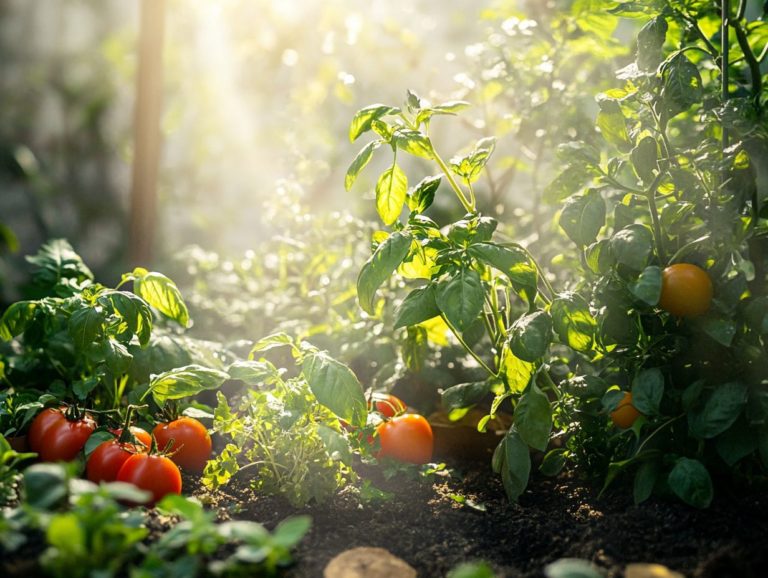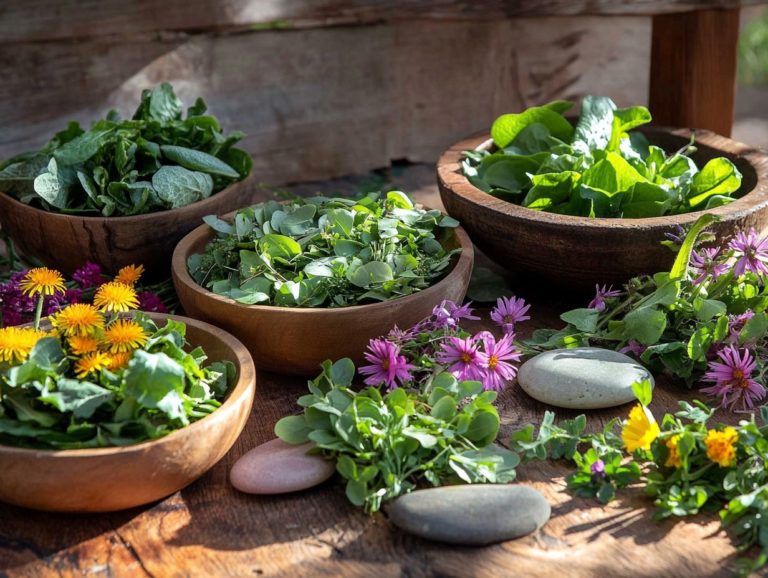Understanding the Life Cycle of Edible Plants
Edible plants play an essential role in your diet. They embark on captivating life cycles that dictate their growth and yield.
This article will guide you through each stage of their journey, from the moment a seed begins to germinate to the flourishing of flowers and the production of fruit. You ll uncover how environmental factors and growing techniques shape these stages, along with valuable tips for harvesting and storing your bounty efficiently.
Dive into the fascinating realm of edible plants and discover how to nurture them for the best possible results.
Contents
- Key Takeaways:
- Stages of the Life Cycle
- Factors Affecting the Life Cycle
- Harvesting and Storage
- Frequently Asked Questions
- What is the life cycle of an edible plant?
- What are the different stages in the life cycle of an edible plant?
- How long does it take for an edible plant to complete its life cycle?
- What is seed germination and why is it important?
- How does the vegetative growth stage affect the life cycle?
- Why is it important to understand the life cycle of edible plants?
Key Takeaways:

- Edible plants go through a series of stages in their life cycle, from seed germination to fruit and seed production.
- The life cycle of edible plants is affected by various factors such as climate, environmental conditions, and growing techniques.
- Proper harvesting and storage techniques are essential for preserving the quality and freshness of edible plants.
What are Edible Plants?
Edible plants present a remarkable array of species that provide vital nutrients, delightful flavors, and culinary versatility. You can classify these plants into categories such as fruits, vegetables, herbs, and grains, each playing a unique role in your diet and agricultural practices.
Understanding the characteristics of different edible plants like their growth stages, ways to grow new plants, and seasonal growth patterns is crucial for effective gardening and sustainable food production.
Cultivating a diverse selection of edible plants not only enhances biodiversity but also encourages healthier eating habits by ensuring access to fresh, nutritious options.
For example, leafy greens such as kale and spinach are teeming with vitamins, while fruits like berries provide antioxidants that support your overall health. Herbs like basil and cilantro infuse your dishes with unique flavors and may even possess therapeutic properties. Grains like quinoa and millet are vital for food security, delivering valuable sources of protein and energy.
Incorporate these diverse plants into your garden and watch your ecosystem thrive!
Stages of the Life Cycle
The life cycle of plants unfolds through distinct stages that encompass seed germination, vegetative growth, flowering and pollination, and ultimately fruit and seed production. Each stage is vital for the reproduction and survival of plant species.
By grasping these stages from the dormant seed phase to the dynamic reproductive stage you can optimize growth conditions and enhance crop yields, whether you re a passionate gardener or a dedicated agriculturist.
Understanding this cycle gives you the power to nurture your plants effectively, ensuring their thriving success.
Seed Germination
Seed germination is an essential process where a dormant seed comes to life, sprouting and evolving into a seedling. To kickstart this transformation, it requires optimal conditions like sufficient water, appropriate light exposure, and the right soil moisture levels. This germination phase lays the groundwork for future stages of plant life, significantly influencing root development and the overall health of the plant.
The interaction of various environmental factors is critical in this delicate process. For example, the type of soil you choose can affect how well water and nutrients are retained, while temperature and humidity levels create the ideal microclimate for the seed’s awakening. Essential nutrients like nitrogen and phosphorus are vital in supporting initial growth.
Nurturing these conditions not only boosts germination rates but also leads to healthier and more resilient plants as they advance through their life cycle.
Growth and Development

During the growth stage, you’ll notice significant changes. Plants focus on root development and leaf production, both vital for taking in food and water.
This stage is marked by rapid growth. Plants harness sunlight and water to increase in size.
Roots anchor the plant while absorbing essential minerals and water. Leaves are where photosynthesis happens, turning light energy into food.
Environmental factors like soil quality, moisture, and temperature influence this process. Agricultural practices such as crop rotation and using organic fertilizers enhance nutrient availability.
By adopting a balanced approach, you can optimize growth patterns and maximize your yield.
Flowering and Pollination
Flowering and pollination are crucial stages in the life cycle of flowering plants. They help attract pollinators, which are vital for reproduction.
This process leads to the formation of fruits and seeds, supporting biodiversity. Pollinators like bees, butterflies, and birds interact with flowers, sustaining food webs.
As pollinators move from flower to flower, they ensure genetic diversity. This allows plants to adapt to environmental changes, enhancing global food production.
Without these relationships, ecosystems could be disrupted. This would lead to fewer resources and less plant diversity for survival.
Fruit and Seed Production
The fruit and seed production phase is the pinnacle of a plant’s life cycle. It culminates in creating fruits that house seeds, ready for dispersal.
This process is essential for propagating plant species and varies across different types. Understanding seed production is crucial as it involves interactions between plants and their environments.
Factors like temperature, moisture, and soil quality significantly influence fruit development. Different species use various seed dispersal methods, such as wind or animals.
These strategies help seeds survive and enhance genetic diversity, crucial for resilient crops. By nurturing this diversity, you can adapt to changing conditions and support sustainable farming practices.
Factors Affecting the Life Cycle
Many factors influence the life cycle of plants, from climate and soil quality to the cultivation techniques used by gardeners and farmers.
These elements affect every growth stage, from seed germination to fruit production. They ultimately determine the success of agricultural crops and gardening efforts.
Climate and Environmental Conditions

Climate and environmental conditions are pivotal in determining the success of your plants. Factors such as soil moisture, sunlight exposure, and temperature are essential for achieving optimal growth. By understanding these conditions, you can select plant species. Choose those that thrive in your specific environment.
Temperature variations can dictate how quickly your seedlings emerge. Inconsistent rainfall might lead to drought stress or over-saturation both of which can harm plant health. Light levels during different growth stages are just as critical; for instance, ensuring adequate sunlight during the flowering phase is vital for successful fruit set.
By grasping the interplay of these elements, you can refine your gardening and agricultural practices. Adjusting planting dates or implementing targeted irrigation strategies can significantly enhance your crop yields and bolster plant resilience against climate variability.
Cultivation and Care
Cultivation and care are essential for your plants’ successful growth, involving techniques designed to enhance nutrient absorption, optimize water needs, and support healthy root development throughout the crop cycle. Proper care not only boosts plant health but also maximizes yields. This is crucial whether you re nurturing a backyard garden or managing a commercial farm.
Employing diverse methods like crop rotation, companion planting, and organic fertilizers is key to fostering robust growth. Rotating your crops prevents the loss of nutrients and minimizes pest infestations. Companion planting enhances pollination and pest management. Understanding the specific water needs of different plant species allows you to provide adequate moisture without risking waterlogging, safeguarding against diseases.
You can implement mulching practices to conserve soil moisture and suppress weeds, creating a nurturing environment for your plants to flourish.
Harvesting and Storage
Harvesting and storage are essential elements of the food production process, requiring best practices to ensure that edible plants preserve their quality, flavor, and nutritional values after harvesting. Knowing how your plants grow and the conditions they thrive in can make all the difference!
By understanding the optimal timing for harvest and employing the correct storage techniques, you can significantly extend the longevity and usability of various crops.
Harvesting and Preserving Tips
Implementing best practices for harvesting and preserving edible plants is essential for maximizing their flavor, nutritional content, and shelf life. Techniques such as careful harvesting, proper cleaning, and suitable storage methods will help you retain the quality of your fruits and vegetables, ensuring they stay fresh for your enjoyment.
To achieve this effectively, pay attention to the timing of your harvest. Picking plants during the early morning hours often results in the best flavors and textures. Gentle handling is crucial; bruising can compromise both taste and longevity.
Once you’ve harvested your bounty, wash them with care to prevent moisture retention that could lead to spoilage. Using breathable containers for storage helps maintain airflow and reduces mold growth. Understanding the ideal temperature and humidity conditions for specific plants can significantly enhance your preservation efforts, allowing you to savor these nutritious crops for longer.
Start applying these practices today for a thriving garden!
Frequently Asked Questions

What is the life cycle of an edible plant?
The life cycle of an edible plant includes stages from seed to maturity. This process leads to the production of fruits or vegetables.
What are the different stages in the life cycle of an edible plant?
It typically consists of four stages: seed germination, vegetative growth, flowering, and fruit production. Each stage is crucial for the plant’s development.
How long does it take for an edible plant to complete its life cycle?
The time varies by plant type and conditions. On average, it takes about 3-6 months for an edible plant to mature and yield produce.
What is seed germination and why is it important?
Seed germination is when a seed starts to grow into a new plant. This process is vital as it sets the foundation for the plant’s future success.
How does the vegetative growth stage affect the life cycle?
During vegetative growth, the plant develops its leaves and stems. This stage is essential for creating a strong plant that can produce more fruits later.
Why is it important to understand the life cycle of edible plants?
Knowing the life cycle empowers you to grow a thriving garden! You can make informed decisions about planting and caring for your plants to ensure a successful harvest.






